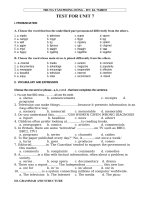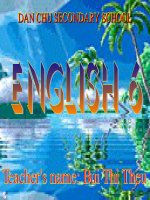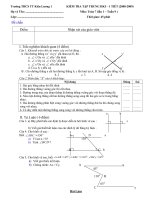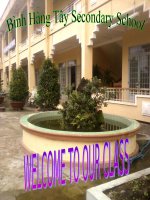unit 7 skills 1 thcs long biên
Bạn đang xem bản rút gọn của tài liệu. Xem và tải ngay bản đầy đủ của tài liệu tại đây (295.25 KB, 13 trang )
<span class='text_page_counter'>(1)</span><div class='page_container' data-page=1>
<b>English 8</b>
<b>UNIT 7 . </b>
<b>POLLUTION</b>
<b>SKILLS 1</b>
</div>
<span class='text_page_counter'>(2)</span><div class='page_container' data-page=2></div>
<span class='text_page_counter'>(3)</span><div class='page_container' data-page=3>
<b>A. READING. </b>
<b>- sewage (n): nước thải sống, nước cống </b>
<b>- household (n): hộ gia đình </b>
<b>- pesticide (n): thuốc trừ sâu </b>
<b>- herbicide (n): thuốc diệt cỏ </b>
<b>- factor (n): nhân tố </b>
<b>- dramatic (adj): kịch tính, sâu sắc</b>
<b>- outbreak (n): sự phun ra, sự bùng phát</b>
<b>- cholera (n): bệnh tả </b>
<b>- untreated (adj): không xử lý </b>
</div>
<span class='text_page_counter'>(4)</span><div class='page_container' data-page=4></div>
<span class='text_page_counter'>(5)</span><div class='page_container' data-page=5>
1. Work in pair. One of you looks at picture A, and the other
looks at picture B on page 15, Ask each other questions to find
out the differences between your pictures
<b>PICTURE A</b> <b>PICTURE B</b>
The ducks are white The ducks are black
They’re going to the lake They’re going from the lake
There aren’t any factories
near the lake
There are some factories
near the lake
The lake water is clean The lake water is dirty
</div>
<span class='text_page_counter'>(6)</span><div class='page_container' data-page=6>
<b>2. Mi and Nick have decided to give a presentation on water </b>
<b>pollution to the class. Read what they have prepared and answer </b>
<b>the questions.</b>
Water pollution is the contamination of bodies of water such
as lakes, rivers, oceans and groundwater (the water beneath the
Earth’s surface). It is one of the most serious types of pollution.
Water pollution can have many different causes. Factories
dump industrial waste into lakes and rivers. Sewage from
households is another cause. Farms using pesticides to kill
insects and herbicides to kill weeds can also lead to water
pollution. These factors cause ‘point source’ pollution while
pollutants from storm water and the atmosphere result in
‘non-point source’ pollution.
</div>
<span class='text_page_counter'>(7)</span><div class='page_container' data-page=7>
Water pollution can have dramatic effects. In
many poor nations, there are frequent outbreaks of
cholera and other diseases because of people
drinking untreated water. Humans can even die if
they drink contaminated water. Polluted water also
causes the death of aquatic animals such as fishes,
crabs, or birds. Other animals eat these dead
animals and may also get sick. In addition,
herbicides in water can kill aquatic plants and
cause further damage to the environment.
</div>
<span class='text_page_counter'>(8)</span><div class='page_container' data-page=8>
* Answer the questions:
1. What does the second paragraph tell you about?
2. What does the third paragraph tell you about?
3. What is groundwater?
4. What are point source pollutants?
5. What are non-point source pollutants?
6. Why do people use herbicides?
<b> </b><i><b>The second paragrah tells us about the causes of water pollution.</b></i>
<i><b>The third paragraph tells about the effects of water pollution.</b></i>
<b> It’s the water beneath the earth’s surface.</b>
<b> </b><i><b>They are industrial waste, sewage, pesticides and herbicides.</b></i>
<b> They are pollutants from storm water and the atmostphere.</b>
</div>
<span class='text_page_counter'>(9)</span><div class='page_container' data-page=9>
<b>3. Read the text again and complete the notes about the effects of </b>
<b>water pollution. Fill each blank with no more than three words.</b>
1. If the drinking water is untreated, an outbreak of
………may happen.
2. People drinking contaminated water may ………
3. Fish, crabs or birds, may also die because of ………
4. Other animals may become ill if they eat the ………...
animals.
5. Herbicides kill both weeds and ………...
<i><b>cholera</b></i>
<i><b>die</b></i>
<i><b>polluted water</b></i>
<i><b>dead</b></i>
</div>
<span class='text_page_counter'>(10)</span><div class='page_container' data-page=10>
4. Work in groups and discuss the solutions to water
pollution. Make notes of your answers.
1. Give heavy fines to companies that are found doing
this.
2. Educate companies about the environment.
3. Give tax breaks to companies that find “clean” ways
to dispose of their waste.
</div>
<span class='text_page_counter'>(11)</span><div class='page_container' data-page=11>
5. Now complete the diagram of water pollution. Use the
information from the text for the causes and effects and
your group’s ideas for the solutions.
<b>Water </b>
<b>pollution</b>
<b>The contamination of bodies of water such as </b>
<b>lakes, oceans and groundwater.</b>
Cause -Point source pollutants: industrial waste,
sewage, pesticides, herbicides.
- non-point pollutants: pollutants from storm
water and atmosphere.
Effect -Human: die if they drink contaminated water.
-Animals: die - plants: killed.
</div>
<span class='text_page_counter'>(12)</span><div class='page_container' data-page=12></div>
<span class='text_page_counter'>(13)</span><div class='page_container' data-page=13>
<b>IV. Homework:</b>
- <b><sub>Learn by heart the vocabulary.</sub></b>
- <b><sub>Do the exercises D1,2- 7 (Workbook)</sub></b>
</div>
<!--links-->









